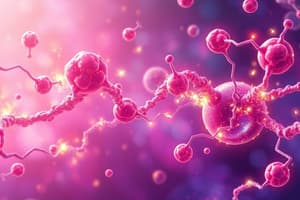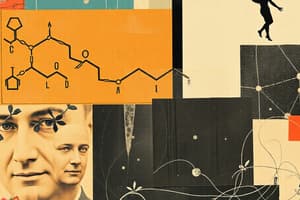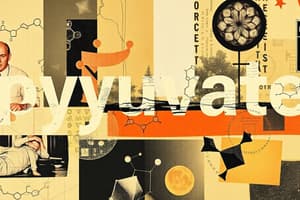Podcast
Questions and Answers
What is the main molecule that pyruvate is converted into in the mitochondrion?
What is the main molecule that pyruvate is converted into in the mitochondrion?
- Lactate
- Acetyl-COA (correct)
- Oxaloacetate
- Succinate
Which gas is necessary for pyruvate to enter the mitochondrion and be transformed into Acetyl-COA?
Which gas is necessary for pyruvate to enter the mitochondrion and be transformed into Acetyl-COA?
- CO2
- N2
- O2 (correct)
- H2
What process allows pyruvate to move into the mitochondrion?
What process allows pyruvate to move into the mitochondrion?
- Pinocytosis
- Facilitated Diffusion
- Active Transport (correct)
- Diffusion
What occurs to pyruvate during its transformation in the mitochondrion?
What occurs to pyruvate during its transformation in the mitochondrion?
Which of the following best describes the end product of glycolysis?
Which of the following best describes the end product of glycolysis?
What is the primary function associated with the process described in the content?
What is the primary function associated with the process described in the content?
Which amino acid is involved in the transamination process as mentioned?
Which amino acid is involved in the transamination process as mentioned?
Which process is primarily linked to the formation of glutamate?
Which process is primarily linked to the formation of glutamate?
What is α-Ketoglutarate's main role in the content?
What is α-Ketoglutarate's main role in the content?
Which two components are specifically mentioned in relation to anabolic functions?
Which two components are specifically mentioned in relation to anabolic functions?
What type of gradient is created across the inner mitochondrial membrane?
What type of gradient is created across the inner mitochondrial membrane?
Where are there more positive charges during the generation of the electrical gradient?
Where are there more positive charges during the generation of the electrical gradient?
What effect does the electrical gradient have on cellular processes?
What effect does the electrical gradient have on cellular processes?
Which statement accurately describes the charge difference across the mitochondrial membrane?
Which statement accurately describes the charge difference across the mitochondrial membrane?
Which component primarily contributes to the establishment of the electrical gradient in mitochondria?
Which component primarily contributes to the establishment of the electrical gradient in mitochondria?
What is the primary molecule formed from the interaction of ribulose-5-phosphate in the non-oxidative phase?
What is the primary molecule formed from the interaction of ribulose-5-phosphate in the non-oxidative phase?
How many molecules of ribulose-5-phosphate are mentioned as participating in the non-oxidative phase?
How many molecules of ribulose-5-phosphate are mentioned as participating in the non-oxidative phase?
Which of the following molecules is NOT formed during the non-oxidative phase?
Which of the following molecules is NOT formed during the non-oxidative phase?
What type of phase is described in the content concerning the conversion of molecules?
What type of phase is described in the content concerning the conversion of molecules?
Which two types of molecules are generated from the conversion involving ribulose-5-phosphate?
Which two types of molecules are generated from the conversion involving ribulose-5-phosphate?
What role does glycogen synthase play in glycogen synthesis?
What role does glycogen synthase play in glycogen synthesis?
How many glucose units does glycogen synthase elongate branches by during glycogen synthesis?
How many glucose units does glycogen synthase elongate branches by during glycogen synthesis?
What type of bonds does glycogen synthase create during glycogen elongation?
What type of bonds does glycogen synthase create during glycogen elongation?
What molecule is primarily responsible for initiating the elongation of glycogen?
What molecule is primarily responsible for initiating the elongation of glycogen?
What is primarily formed by the action of glycogen synthase?
What is primarily formed by the action of glycogen synthase?
Flashcards are hidden until you start studying
Study Notes
Pyruvate Transport and Oxidative Decarboxylation
- Pyruvate, the end product of glycolysis, is transported into the mitochondrion by a special pyruvate transporter in the presence of oxygen.
- Inside the mitochondrion, pyruvate undergoes oxidative decarboxylation, converting it into Acetyl-CoA.
- This process involves the removal of a carbon dioxide molecule from pyruvate.
Anabolic Functions of Acetyl-CoA
- Acetyl-CoA plays a crucial role in the formation of amino acids.
- One of the primary amino acids produced is α-ketoglutarate, which is formed through a process called transamination involving Glutamate.
Mitochondrial Membrane Gradient and Non-Oxidative Phase
- The oxidative decarboxylation of pyruvate creates an electrical gradient across the inner mitochondrial membrane.
- This gradient results in a higher concentration of positive charges on the outside of the membrane compared to the inside.
- The non-oxidative phase of the pentose phosphate pathway is reversible and involves the interconversion of molecules.
- Three molecules of ribulose-5-phosphate are converted into two molecules of glucose-6-phosphate and one molecule of glyceraldehyde-3-phosphate.
Glycogen Synthesis
- Glycogen synthase is a key enzyme involved in the synthesis of glycogen.
- UDP-glucose molecules are added to a glycogen primer, leading to the elongation of α1-4 branches up to 12-14 glucose units.
Studying That Suits You
Use AI to generate personalized quizzes and flashcards to suit your learning preferences.




